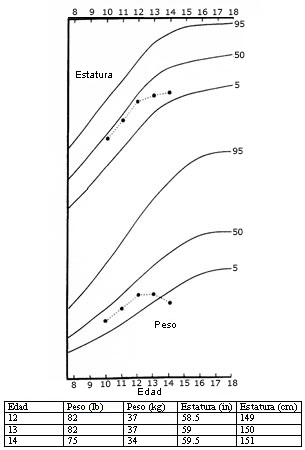Resumo
Definición
Anamnesis y examen
Principales factores de diagnóstico
- presencia de factores de riesgo
- peso corporal significativamente bajo
- temor a ganar peso o a ponerse gordo, o comportamientos que interfieren con el aumento de peso a pesar de haber evidencias de que el peso corporal es significativamente bajo
- imagen corporal distorsionada
- restricción calórica
- atracones y/o purgas
- abuso de laxantes, diuréticos o píldoras adelgazantes
- amenorrea
- disminución de grasa subcutánea
Otros factores de diagnóstico
- fatiga general, debilidad muscular y mala concentración
- preocupación significativa con pensamientos sobre la comida
- hipotensión ortostática
- síntomas gastrointestinales inespecíficos
- síntomas y signos cardíacos
- cambios en el pelo, la piel y las uñas
- edema postural
- osteopenia u osteoporosis
Factores de riesgo
- sexo femenino
- adolescencia y pubertad
- rasgos obsesivos y perfeccionistas
- exposición a los medios occidentales
- influencia genética
- clases socioeconómicas media y alta
- atleta
- burlas relacionadas con la apariencia
- maltrato infantil
- enfermedad celíaca
- Diabetes mellitus de tipo 1
Pruebas diagnósticas
Primeras pruebas diagnósticas para solicitar
- diagnóstico clínico
- hemograma completo (HC)
- química sérica
- pruebas de función tiroidea
- pruebas de función hepática
- glucemia
- análisis de orina
- Prueba Sit Up-Stand-Squat (SUSS)
Pruebas diagnósticas que deben considerarse
- Cuestionario SCOFF (por sus siglas en inglés: sick, control, one, fat, food) )
- electrocardiograma (ECG)
- densitometría ósea (radioabsorciometría de doble energía)
- estradiol en las mujeres
- testosterona en los hombres
- prueba de embarazo en orina o suero
Algoritmo de tratamiento
médicamente estable y apto para el tratamiento ambulatorio
clínicamente inestable o fracaso del manejo ambulatorio
Colaboradores
Autores
Evelyn Attia, MD
Professor of Psychiatry
Columbia University and Weill Cornell Medical College
New York
NY
Divulgaciones
EA receives royalties from UpToDate and Oxford University Press for authorship and has served as a clinical advisor to Equip Health, Inc.
B. Timothy Walsh, MD
Professor of Psychiatry
Columbia University
New York
NY
Divulgaciones
BTW has received royalties and honoraria for writing, editing, speaking, or consulting from Guilford Publications, McGraw-Hill, Oxford University Press, UpToDate, Wiley, the University of British Columbia, Silverhill Hospital, the University of Alabama, the American Society for Clinical Psychopharmacology, Health Advances, and Dell Medical School.
Agradecimientos
Professor Evelyn Attia and Professor B. Timothy Walsh would like to gratefully acknowledge Dr Pauline S. Powers and Dr Abby M. Irwin, previous contributors to this topic.
Divulgaciones
PSP and AMI declare that they have no competing interests.
Revisores por pares
Heather Thompson-Brenner, MD
Director
Eating Disorders Program Center for Anxiety and Related Disorders
Psychology Department
Boston University
Boston
MA
Divulgaciones
HTB declares that she has no competing interests.
Agradecimiento de los revisores por pares
Los temas de BMJ Best Practice se actualizan de forma continua de acuerdo con los desarrollos en la evidencia y en las guías. Los revisores por pares listados aquí han revisado el contenido al menos una vez durante la historia del tema.
Divulgaciones
Las afiliaciones y divulgaciones de los revisores por pares se refieren al momento de la revisión.
Referencias
Artículos principales
American Psychiatric Association. Diagnostic and statistical manual of mental disorders, 5th ed., text revision (DSM-5-TR). Washington, DC: American Psychiatric Publishing; 2022.
National Institute for Health and Care Excellence. Eating disorders: recognition and treatment. Dec 2020 [internet publication].Texto completo
American Psychiatric Association. Practice guideline for the treatment of patients with eating disorders. Feb 2023 [internet publication].Texto completo
Royal College of Psychiatrists. Medical emergencies in eating disorders (MEED): guidance on recognition and management. Oct 2023 [internet publication].Texto completo
Hornberger LL, Lane MA, Committee on Adolescence. Identification and management of eating disorders in children and adolescents. Pediatrics. 2021 Jan;147(1):e2020040279.Texto completo Resumen
Artículos de referencia
Una lista completa de las fuentes a las que se hace referencia en este tema está disponible para los usuarios con acceso a todo BMJ Best Practice.

Diferenciales
- Bulimia nerviosa
- Trastorno de ingesta de alimentación selectiva (ARFID)
- Depresión
Más DiferencialesGuías de práctica clínica
- Determining treatment goal weights for children and adolescents with anorexia nervosa
- Practice guideline for the treatment of patients with eating disorders
Más Guías de práctica clínicaFolletos para el paciente
Anorexia
Anorexia: preguntas que debe hacer a su médico
Más Folletos para el pacienteCalculadoras
Percentiles de índice de masa corporal (IMC) para niños (entre 2 y 20 años)
Percentiles de índice de masa corporal (IMC) para niñas (entre 2 y 20 años)
Más CalculadorasInicie sesión o suscríbase para acceder a todo el BMJ Best Practice
El uso de este contenido está sujeto a nuestra cláusula de exención de responsabilidad
